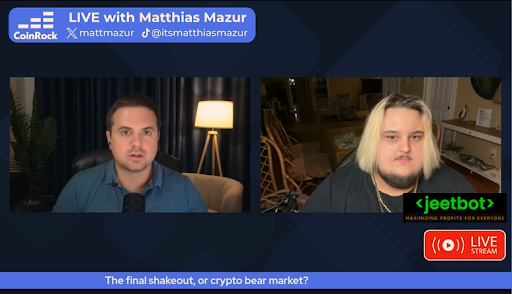The crypto world is buzzing with uncertainty. Is this the dreaded final shakeout before a bull run, or are we staring at the abyss of a prolonged bearish market?
In a power-packed episode of The CoinRock Show, host Matthias and special guest Lucas, aka BlockchainBoy, break down the current state of the market, shedding light on what’s happening behind the scenes in both retail and institutional circles.
From memecoin meltdowns to institutional plays, they navigate the chaos, providing insights that every trader, builder, and investor needs to hear.

Will We Succeed or Struggle at Market Crossroads?
Matthias and Lucas agree on one thing: the current crypto market is not for the faint-hearted. While Bitcoin has shown resilience, hovering near $70,000, altcoins have taken a beating, with some losing over 40-60% from their recent highs.
On-chain data shows that Bitcoin dominance has increased to over 52%, a sign that investors are rotating out of riskier assets and into the most established cryptocurrency.
The market is experiencing a stark contrast between institutional confidence and retail panic, leading to one of the most painful cycles in recent history.
“This is the first cycle where the institutional and retail mindsets have been completely opposed. Institutions are calm, while retail is in full panic mode.” — Matthias
Unlike past cycles, where retail speculation fueled explosive gains, this time, institutions are dictating market movements. Data from Farside Investors indicates that Bitcoin Spot ETFs have seen consistent inflows, adding over $1 billion in net inflows in the past month alone. Giants like BlackRock, Citadel, and Fidelity are increasing their exposure through ETFs and OTC (Over-the-Counter) desk purchases, which are not reflected in retail exchange volumes.
Moreover, CoinShares’ weekly fund flow report shows that institutional demand for crypto assets remains strong, with crypto investment products seeing a $2.9 billion inflow over the past month. The grayscale GBTC outflows have stabilized, meaning that early ETF investors who sold are now being replaced by long-term holders.
Institutions are not selling into the fear; they are quietly accumulating while retail traders are panic-sell at a loss.
“If you’re watching the headlines, institutions are not worried. They see the long-term play, while retail gets wiped out in emotional trading.” — Lucas

Retail’s Downfall is Overleveraging and Fear
Both speakers emphasize how retail traders have shot themselves in the foot this cycle. Unlike previous years, where retail speculation fueled explosive gains, this time, institutions dictate the flow.
On-chain data from Santiment and IntoTheBlock show that retail activity has drastically declined, with many short-term traders exiting positions at significant losses. The crypto derivatives market, which has grown exponentially, has become a double-edged sword for retail investors.
Lucas highlights a key issue: overexposure and overtrading. Memecoin trading volumes surged by over 300% in early 2024, with tokens like Dogwifhat (WIF) and Book of Meme (BOME) seeing parabolic rallies before crashing.
According to Coinglass, over $1.2 billion worth of liquidations occurred in a single week, with the majority coming from overleveraged long positions on Binance, Bybit, and OKX. As traders saw their meme coin gains disappear, many flocked to perpetual contracts (perps) in an attempt to recover losses, only to get liquidated again.
“This market is brutal. People think they can make it back in one trade, but that’s the fastest way to lose everything.” — Lucas
Matthias echoes the sentiment, urging traders to recognize when to be patient instead of making emotional moves. The data supports his claim historically, the crypto market sentiment follows a predictable pattern.
According to Google Trends and on-chain sentiment indicators, retail interest in Bitcoin and altcoins peaked during major price surges and declined sharply after corrections, mirroring past cycles. Bitcoin’s Relative Strength Index (RSI) also shows that buying interest is at its lowest during corrections, precisely when institutions accumulate.
“Retail attention is always highest at the top and lowest when it’s time to accumulate. That’s why institutions win—they do the opposite.” — Matthias
Why Institutions Are Bullish While Retail Panics
Despite widespread fear in the retail sector, big-money players are betting big on crypto, signaling long-term confidence in the market. The CoinRock team, along with other industry insiders, confirm that institutional players are not only holding but increasing their positions.
Crypto-focused hedge funds, venture capital firms, and centralized exchanges (CEXs) are still investing heavily in marketing and expansion efforts. According to Galaxy Digital Research, institutional investors allocated over $78 billion in digital asset investments in 2024, a record-breaking number.
Furthermore, data from Kaiko Analytics shows that centralized exchanges like Binance, Coinbase, and Bybit continue to onboard new institutional clients, despite lower retail activity.
Executives from major centralized exchanges also see this dip as a temporary pullback rather than a long-term trend reversal. Reports from CoinShares’ Digital Asset Fund Flows reveal that institutional investment products saw a net inflow of $2.9 billion in just the last four weeks, signaling confidence among high-net-worth investors.
Additionally, Bitcoin Spot ETFs, introduced in early 2024, have absorbed over $1 billion in inflows in a single month, further proving that large-scale investors are committed to crypto’s future.
Venture capital firms and family offices are continuing to deploy capital into blockchain infrastructure, Web3 startups, and AI-integrated crypto projects. According to PitchBook, blockchain startups secured over $4.1 billion in venture capital funding in Q1 2024, marking a 52% increase from the previous quarter.
The presence of firms like Andreessen Horowitz, Sequoia Capital, and Pantera Capital, which are doubling down on investments, indicates that institutional confidence in crypto remains unshaken.
Matthias highlights how market makers like Citadel Securities, a powerhouse in traditional finance, are now playing a major role in the crypto market, proving that digital assets have entered a new phase of institutional adoption.
Historically, firms like Citadel avoided crypto due to regulatory uncertainties and market volatility, but now, with increasing demand and more structured trading products, they are moving in aggressively.
“Citadel and other financial giants didn’t even touch crypto last cycle. Now they’re moving in aggressively. That should tell you everything.” — Matthias

Prolonged Bull Run or Market Downturn?
Lucas predicts that we’re in for a longer cycle with brutal corrections but not a bear market. Unlike past cycles, where retail-driven speculation led to rapid boom-and-bust cycles, the current phase is being shaped by institutional money, structured financial products, and a maturing regulatory landscape.
On-chain data from Glassnode suggests that long-term Bitcoin holders are not selling, with over 80% of the BTC supply remaining unmoved for more than six months, a strong indication that conviction remains high among large investors.
Matthias agrees, emphasizing that the narrative cycle is shifting away from hype-driven meme pumps and toward projects with real-world use cases and strong fundamentals. Sectors like Layer 2 scaling solutions, decentralized finance (DeFi), real-world asset tokenization (RWA), and artificial intelligence-driven blockchain applications are attracting the most capital.
Reports from Messari and PitchBook show that institutional funding has increasingly shifted toward these sectors, proving that serious investors are looking beyond short-term speculation.
“This is the rotation to quality. The era of random coins going 100x overnight is fading, but serious projects are going to thrive.” — Lucas
Both agree that while retail traders are currently suffering, this is exactly when the biggest money is made. Historical data from previous cycles, particularly from 2018-2019 and 2022-2023, shows that the most lucrative entries occur when fear is at its highest. Crypto sentiment indicators, such as the Bitcoin Fear & Greed Index, are currently flashing fear, which has often preceded market recoveries.
“The key to winning in this market is patience, discipline, and avoiding emotional trading.” — Matthias
While volatility remains high, those who stay focused on long-term trends rather than short-term noise are likely to emerge as the biggest winners of the next phase of crypto’s evolution.
The Takeaway for Crypto Investors
The biggest mistake retail traders can make right now is losing interest and checking out. Historically, bearish sentiment and market fatigue have always preceded the strongest bull runs, and data from Google Trends and on-chain activity show that retail engagement is currently at its lowest point in months. However, those who stay focused during these uncertain times position themselves for the biggest gains when the market inevitably turns.
“This is when you should be paying attention the most. The best trades are made in the worst times.” — Matthias
Lucas provides a powerful reality check for traders, reminding them that investing without a clear thesis is just gambling. The last market cycle saw many projects with no real value surge purely on speculation only for most to collapse. This time around, projects with strong fundamentals, real utility, and institutional backing are more likely to thrive.
“You need to ask yourself: are you holding based on hype, or do you actually understand why you’re in crypto? If you don’t have a thesis, you’re just gambling.” — Lucas
In short, the shakeout is brutal, but it’s not the end. Data from previous cycle corrections in 2018, 2020, and 2022 show that many of the best-performing assets of the next bull run were accumulated during market downturns. Those who survive the volatility, make smart plays, and remain patient will be in the best position when the next major rally begins.
For now, strategy and discipline will determine who makes it through and who doesn’t.




